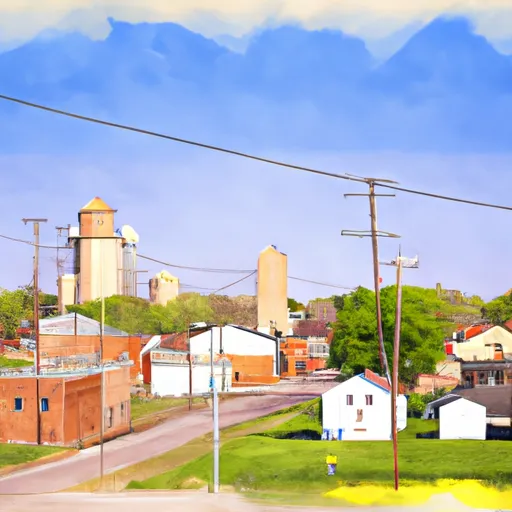-
 Snoflo Premium
Snoflo Premium
Get unlimited access to all our content
With no Ad interruptions! - Start Your Free Trial Login with existing account
Wilmore
Eden Index
Climate
8.1
•
Recreation
•
Community
•
Safeguard
3.2/10

Wilmore, Kansas is a small town located in Comanche County, in the central part of the state. The climate in Wilmore is categorized as a humid continental climate, with hot summers and cold winters. Summers are typically warm, with average temperatures ranging from the mid-70s to low 90s Fahrenheit, while winters are cold with average temperatures in the 20s to 30s. The area receives moderate precipitation throughout the year, with the majority occurring during the spring and early summer months.
Hydrologically, Wilmore sits within the Great Plains region and is not near any major bodies of water. The town relies on local wells and aquifers for its water supply.
Despite its small size, Wilmore offers several outdoor recreation opportunities. The nearby Cimarron National Grassland provides visitors with opportunities for hiking, camping, and wildlife observation. The grassland is home to a diverse range of plant and animal species, making it an ideal destination for nature enthusiasts. Additionally, the nearby Clark State Fishing Lake offers fishing and boating opportunities, allowing visitors to enjoy the serene beauty of the lake while indulging in recreational activities. Overall, Wilmore serves as a gateway to outdoor adventures in the scenic beauty of the Kansas prairie.
What is the Eden Index?
The Snoflo Eden Index serves as a comprehensive rating system for regions, evaluating their desirability through a holistic assessment of climate health, outdoor recreation opportunities, and natural disaster risk, acknowledging the profound impact of these factors on livability and well-being.
Climate Health Indicator (CHI): 8.1
Wilmore receives approximately
648mm of rain per year,
with humidity levels near 81%
and air temperatures averaging around
14°C.
Wilmore has a plant hardyness factor of
6, meaning
plants and agriculture in this region thrive during a short period during spring and early summer. Most
plants will die off during the colder winter months.
By considering the ideal temperature range, reliable water supplies, clean air, and stable seasonal rain or snowpacks, the Climate Health Indicator (CHI) underscores the significance of a healthy climate as the foundation for quality living.
A healthy climate is paramount for ensuring a high quality of life and livability in a region, fostering both physical well-being and environmental harmony. This can be characterized by ideal temperatures, reliable access to water supplies, clean air, and consistent seasonal rain or snowpacks.
Weather Forecast
Streamflow Conditions
Arkansas - Keystone
Area Rivers
Arkansas - Keystone
Snowpack Depths
Arkansas - Keystone
Reservoir Storage Capacity
Arkansas - Keystone
Groundwater Levels
Recreational Opportunity Index (ROI):
The Recreational Opportunity Index (ROI) recognizes the value of outdoor recreational options, such as parks, hiking trails, camping sites, and fishing spots, while acknowledging that climate plays a pivotal role in ensuring the comfort and consistency of these experiences.
Access to outdoor recreational opportunities, encompassing activities such as parks, hiking, camping, and fishing, is crucial for overall well-being, and the climate plays a pivotal role in enabling and enhancing these experiences, ensuring that individuals can engage in nature-based activities comfortably and consistently.
Camping Areas
| Campground | Campsites | Reservations | Toilets | Showers | Elevation |
|---|---|---|---|---|---|
| Camp Pawnee | 12 | 2,028 ft | |||
| Boiling Springs State Park | None | 1,876 ft | |||
| Grass Park - La Crosse | 4 | 2,053 ft | |||
| Lake Coldwater | None | 2,022 ft | |||
| Alabaster Caverns State Park | None | 1,726 ft |
Nearby Ski Areas
Catastrophe Safeguard Index (CSI):
The Catastrophe Safeguard Index (CSI) recognizes that natural disaster risk, encompassing floods, fires, hurricanes, and tornadoes, can drastically affect safety and the overall appeal of an area.
The level of natural disaster risk in a region significantly affects safety and the overall livability, with climate change amplifying these risks by potentially increasing the frequency and intensity of events like floods, fires, hurricanes, and tornadoes, thereby posing substantial challenges to community resilience and well-being.
Community Resilience Indicator (CRI):
The Community Resilience Indicator (CRI) recognizes that education, healthcare, and socioeconomics are crucial to the well-being of a region. The CRI acknowledges the profound impact of these elements on residents' overall quality of life. By evaluating educational resources, healthcare accessibility, and economic inclusivity, the index captures the essential aspects that contribute to a thriving community, fostering resident satisfaction, equity, and social cohesion.

